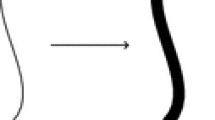Abstract
Complete characterizations are given for those trees that can be drawn as either the relative neighborhood graph, relatively closest graph, Gabriel graph, or modified Gabriel graph of a set of points in the plane. The characterizations give rise to linear-time algorithms for determining whether a tree has such a drawing; if such a drawing exists one can be constructed in linear time in the real RAM model. The characterization of Gabriel graphs settles several conjectures of Matula and Sokal [17].
Similar content being viewed by others
References
P. K. Agarwal and J. Matoušek. Relative Neighbourhood Graphs in Three Dimensions.Computational Geometry: Theory and Applications,2 (1992), 1–14.
J. A. Bondy and U. S. R. Murty.Graph Theory with Applications. Elsevier, New York, 1976.
R. J. Cimikowski. Properties of Some Euclidean Proximity Graphs.Pattern Recognition Letters,13 (1992), 417–423.
G. Di Battista, P. Eades, R. Tamassia, and I. G. Tollis. Algorithms for Automatic Graph Drawing: An Annotated Bibliography.Computational Geometry: Theory and Applications,4 (1994), 235–282.
G. Di Battista and L. Vismara. Angles of Planar Triangular Graphs.Proceedings of the ACM Symposium on Theory of Computing, 1993, pp. 431–437.
M. B. Dillencourt. Graph-Theoretical Conditions for Inscribability and Delaunay Realizability. Technical Report 92-90, University of Califoria Irvine.
P. Eades and S. Whitesides. Personal communication, 1993.
H. Edelsbrunner, D. G. Kirkpatrick, and R. Seidel. On the Shape of a Set of Points in the Plane.IEEE Transaction on Information Theory,29 (1983), 551–559.
I. Fary. On Straight Lines Representation of Planar Graphs.Acta Scientiarum Mathematicarum (Szeged),11 (1948), 229–233.
K. R. Gabriel and R. R. Sokal. A New Statistical Approach to Geographical Analysis.Systematic Zoology,18 (1969), 54–64.
J. Garcia. A Counter-Example to a Theorem of Sendov. Manuscript in preparation.
M. S. Jacobson, M. J. Lipman, and F. R. McMorris. Trees That Are Sphere-of-Influence Graphs. Technical Report 0191/2, University of Louisville.
J. W. Jaromczyk and G. T. Toussaint. Relative Neighborhood Graphs and Their Relatives.Proceedings of the IEEE,80(9) (1992), 1502–1517.
D. G. Kirkpatrick and J. D. Radke. A Framework for Computational Morphology. InComputational Geometry, ed. G. T. Toussaint. Elsevier, Amsterdam, 1985, pp. 217–248.
P. M. Lankford. Regionalization: Theory and Alternative Algorithms.Geographical Analysis,1 (1969), 196–212.
A. Lubiw, and N. Sleumer, All Maximal Outerplanar Graphs Are Relative Neighborhood Graphs.Proceedings of the Fifth Canadian Conference on Computational Geometry, Waterloo, 1993, pp. 198–203.
D. W. Matula and R. R. Sokal. Properties of Gabriel Graphs Relevant to Geographic Variation Research and the Clustering of Points in the Plane.Geographical Analysis,12(3) (1980), 205–222.
C. Monma and S. Suri. Transitions in Geometric Minimum Spanning Trees.Proceedings of the ACM Symposium on Computational Geometry, 1991, pp. 239–249.
F. P. Preparata and M. I. Shamos,Computational Geometry —An Introduction. Springer-Verlag, New York, 1985.
J. D. Radke. On the Shape of a Set of Points. InComputational Morphology, ed. G. T. Toussaint. Elsevier, Amsterdam, 1988, pp. 105–136.
B. Sendov. Planar Neighbourhood Graphs Without Cycles.Comptes Rendus de l'Academie Bulgare des Sciences,44(4) (1991), 23–25.
M. I. Shamos and D. Hoey. Closest Point Problem.Proceedings of the 8th Annual IEEE Symposium on the Foundations of Computer Science, 1975, pp. 151–162.
G. T. Toussaint. The Relative Neighborhood Graph of a Finite Planar Set.Pattern Recognition,12 (1980), 261–268.
G. T. Toussaint. Pattern Recognition and Geometrical Complexity.Proceedings of the Fifth International Conference on Pattern Recognition, Miami Beach, 1980, pp. 1340–1347.
G. T. Toussaint. A Graph-Theoretical Primal Sketch. InComputational Morphology, ed. G. T. Toussaint. Elsevier, Amsterdam, 1988, pp. 229–260.
R. B. Urquhart. Some Properties of the Planar Euclidean Relative Neighbourhood Graph.Pattern Recognition Letters,1(5), 1983, 317–322.
R. C. Vetkamp. Theγ-Neighbourhood Graph.Computational Geometry: Theory and Applications,1 (1992), 227–246.
Author information
Authors and Affiliations
Additional information
Communicated by G. Di Battista and R. Tamassia.
This research was conducted while the author was at the School of Computer Science of McGill University. Research supported in part by NSERC and FCAR.
This work was done when this author was visiting the School of Computer Science of McGill University.
This work was done when this author was visiting the School of Computer Science of McGill University.
Rights and permissions
About this article
Cite this article
Bose, P., Lenhart, W. & Liotta, G. Characterizing proximity trees. Algorithmica 16, 83–110 (1996). https://doi.org/10.1007/BF02086609
Received:
Revised:
Issue Date:
DOI: https://doi.org/10.1007/BF02086609



